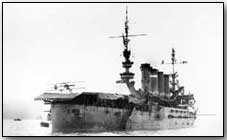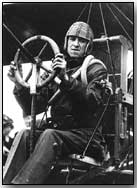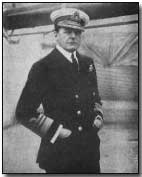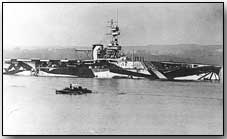The War in the Air - Naval Warfare
 The first time that a plane took off from a ship was on the 10th of November 1910, when
Eugene Ely, flying a Curtiss biplane, took off from the American light
cruiser Birmingham. Two months later he even made the first
landing of an aircraft on a ship's deck, albeit a ship at anchor, the
Pennsylvania.
The first time that a plane took off from a ship was on the 10th of November 1910, when
Eugene Ely, flying a Curtiss biplane, took off from the American light
cruiser Birmingham. Two months later he even made the first
landing of an aircraft on a ship's deck, albeit a ship at anchor, the
Pennsylvania.
Between 1910 and 1914 the navies of all the major protagonists showed interest in using aircraft for reconnaissance purposes. The RNAS experimented with ships carrying small platforms from which aircraft could take off, but takeoff weights were limited and no practical solution to landing was found, as Ely's landing on the Pennsylvania was deemed a feat not repeatable for a ship at sea.
The RNAS found the concept of "seaplane tenders" more practical. These ships carried a small number of seaplanes that could be lowered by crane over the side. At the end of their flight they would land next to the ship and be raised back on deck.
The first seaplane tender was the short lived H.M.S. Hermes, which was torpedoed and sunk in November of 1914. However at the outbreak of the war the Navy requisitioned three cross-channel packet boats and converted them as seaplane tenders. These were the Engadine, Riviera and Empress.
It was from these ships that the raid against the Zeppelin bases at Cuxhaven and Wilhelmshaven was carried out on Christmas Day of 1914. This was the first time ship-borne aircraft were used offensively, and while the raid was not successful in terms of damage inflicted, it proved the practicality of such operations.
 The
navy acquired more seaplane tenders. In 1915 the British launched the
audacious, and ultimately disastrous,
campaign against the Turks at
Gallipoli. At the opening of the campaign the sea-plane tender Ark
Royal provided eight Short 184 seaplanes, which provided reconnaissance
and aerial spotting.
The
navy acquired more seaplane tenders. In 1915 the British launched the
audacious, and ultimately disastrous,
campaign against the Turks at
Gallipoli. At the opening of the campaign the sea-plane tender Ark
Royal provided eight Short 184 seaplanes, which provided reconnaissance
and aerial spotting.
In June it was joined by the Ben-My-Chree. (Erskine Childers, the novelist and Irish revolutionary, served as an observer on the Shorts. He first served on the Engadine in 1914 and participated in the bombing raid against Cuxhaven, and later he served on the Ben-My-Chree during the Gallipoli campaign.)
During the troop landings at Sulva Bay in August these planes spotted for the Naval guns, and even carried out some bombing sorties, impeding Turkish attempts to reinforce their troops. On the 12th of August 1915 C. H. K. Edmonds, flying from the Ben-My-Chree became the first pilot to sink a ship by torpedo when he scored a direct hit on a Turkish merchantman. The Turks later got their revenge on the Ben-My-Chree when their shore artillery sank her on the 11th of January 1917.
The Battle of Jutland took place in May of 1916. The Engadine was a part of the British battle cruiser squadron. When Admiral David Beatty first received reports of enemy vessels he ordered it to launch a seaplane to investigate. Heavy clouds forced the plane to fly at a mere 900 feet above the waves. It encountered four light cruisers, which opened fire but failed to hit it.
The pilot of this plane was F. J. Rutland, who not surprisingly became known thereafter as "Rutland of Jutland". Although this sighting had no marked effect on the conduct of the battle, Beatty was to write that the sighting did, "indicate that seaplane under such circumstance are of distinct value."
Other navies also used seaplane tenders. Most noticeably were the Russians, whose Black Sea fleet used them quite aggressively in their campaign to blockade the Bosphorus and prevent shipments of coal to Istanbul. Their most successful raid was on the 6th of February 1916, when a flight of eleven M-9 seaplanes from the ships Emperor Aleksandr I and Emperor Nikolai I attacked the port of Zonguldak. Among other damage they sank the Turkish collier Jamingard.
 One
of the main duties of the RNAS was to aid in the battle against the U-Boat.
The RNAS employed both seaplanes and non-rigid airships to carry out
reconnaissance missions. The airships were slower, but could carry the
bulky wireless transmitters that were too heavy for the seaplanes.
One
of the main duties of the RNAS was to aid in the battle against the U-Boat.
The RNAS employed both seaplanes and non-rigid airships to carry out
reconnaissance missions. The airships were slower, but could carry the
bulky wireless transmitters that were too heavy for the seaplanes.
The aim of these missions was two-fold: detection, and to force the U-boats underwater as much as possible, in order to make them more vulnerable to attack when they were forced to the surface to recharge their batteries. As the war progressed the RNAS began to use the seaplanes offensively against the U-Boats as well. On the 20th of May, 1917 the UC36 earned the dubious distinction of being the first submarine ever sunk by an aircraft. The UB20 suffered a similar fate in July and the UB32 in August.
The Royal Navy wanted to equip ships with aircraft that could intercept the Zeppelins, and thus deprive the German Navy of its greatest reconnaissance asset. It was clear that the seaplanes, weighed down and cumbersome because of their floats, could not provide the required performance.
With the Sopwith Pup there was finally available a plane that could climb high enough, and fast enough, to tackle the Zeppelins. In addition it required a very small take off run. In fact, flying into a 20 knot wind the Pup required a meagre six metres (20 feet) to take off.
The navy revived the idea of flying wheeled aircraft off from decks. F. J. Rutland, who had flown the reconnaissance mission at Jutland, flew the first such takeoffs from platforms on the Manxman and Campania. The navy subsequently fitted light cruisers with such takeoff platforms.
The solution was far from ideal as there was still no way to land, and the planes had to either land on shore, or if this was too far away, to ditch into the sea. The Pups were supplied with special airbags to keep them afloat until the ship's crane could lift them back up on deck.
On the 21st of August, 1917 a Sopwith Pup piloted by Second Lieutenant B. A. Smart, took off from such a ship, the HMS Yarmouth, which had been escorting a mine-laying force in the Heligoland Bight. Climbing to 7,000 feet he attacked the Zeppelin L23 from above, and shot it down. He subsequently ditched in the sea and was recovered by HMS Prince.
 The
Royal Navy took an even more advanced approach when it changed the layout of
the HMS Furious, then under construction as a light cruiser.
The
Royal Navy took an even more advanced approach when it changed the layout of
the HMS Furious, then under construction as a light cruiser.
They cleared the forward deck of her intended gun turret, and placed instead a takeoff deck 70 metres long and 15 metres wide. (228 feet by 50 feet.) The deck was connected by a hatchway and crane to a hanger which held four seaplanes and six land planes.
The Squadron Commander on the Furious was E. H. Dunning, and he thought he had a solution to the problem of landing. He knew that if the ship, with its top speed 21 knots, sailed directly into a 19 knot wind, the combined speed would match the Pup's 40 knot landing speed.
On the 2nd of August 1917 he demonstrated how this could be used to land the craft on the takeoff deck. He flew alongside the Furious, and as he lowered his speed he was virtually hovering in relation to the deck. He then side-slipped over the ship. Waiting crewmen grabbed prepared ropes and literally pulled the plane down, while Dunning cut the engine at the same time.
He attempted a second landing five days later, but this time instructed the crew not to grab the ropes until the plane had touched down. Something went wrong (it has been variously reported as the engine stalling, or a tyre bursting) but whatever the cause the plane crashed over the side and into the sea. Dunning was knocked unconscious and drowned before he could be rescued. Further attempts to land using this technique were banned.
As an alternative solution the Navy carried out a further modification to the Furious. Her aft gun was removed, and a second 87 metre (285 foot) deck, intending for landing, was located aft of the funnel. Another important change was the installation of lifts to connect between the hanger and the flight decks.
The landing decks were equipped with arrester gear: cables stretched across the deck which were to be snared by horns projecting from the undercarriage. This technique had been successfully tried on shore, but at sea it was a failure. The hot exhaust from the funnel made the air turbulent and the funnel itself blocked the vital headwind.
 Rutland
was one of the pilots who failed to land in these trials, crashing over the
side. He was more fortunate than Dunning and was rescued.
Rutland
was one of the pilots who failed to land in these trials, crashing over the
side. He was more fortunate than Dunning and was rescued.
(During the 1930s Rutland became an advisor on aircraft carriers to the Japanese, who later set him up as a spy in Hawaii and California. In 1941 he returned to England where he was interned without trial until 1944.)
After these initial experiments the idea of landing on the Furious was abandoned, and only her flying off deck was used. On the 19th of July 1918 operation "F7" was launched from her decks. Of the seven Sopwith Camels that took off one turned back with engine trouble, but the other six attacked the Zeppelin base at Tondern, destroying two airships and disabling the base for the rest of the war.
One of the pilots of this mission was B. A. Smart, who had shot down the L23. As on that previous occasion he successfully ditched beside the fleet and was picked up, as was one other pilot. Three others landed in Denmark, and one failed to find the fleet on return. His body was washed up a month later, and it is assumed he drowned after ditching alone at sea.
The experience gained with the Furious paid off. In the autumn of 1918 the navy launched the first true aircraft carrier, the HMS Argus. Exhaust from her engines was channelled aft through ducts and discharged over the stern. The small chart-house on deck could be lowered, leaving the Argus with a clear 168 by 21 metre (550 by 68 foot) flight deck for taking off and landing.
The first deck landings took place in October of 1918. Admiral Beatty put forward a plan to use the Argus, carrying the new Sopwith Cuckoo torpedo bomber, to attack the harbour-bound German High Seas Fleet. The admiralty rejected this plan, but the concept was sound, and was first used to great effect by the British 23 years later against the Italian fleet at Taranto in 1940. This raid greatly influenced the Japanese thinking prior to Pearl Harbour.
The Argus made the concept of the seaplane tender obsolete, and post war developments made the Argus itself obsolete within a few years. Nevertheless, she was used throughout World War II. She served most of the war as a transport for aircraft, but she was also successfully used as a carrier during Operation Harpoon - the supply of Malta - in 1942.
Article contributed by Ari Unikoski
Photographs courtesy of Photos of the Great War website
Next - The Top Air Aces
A 'Tour' was a period of front-line service.
- Did you know?
